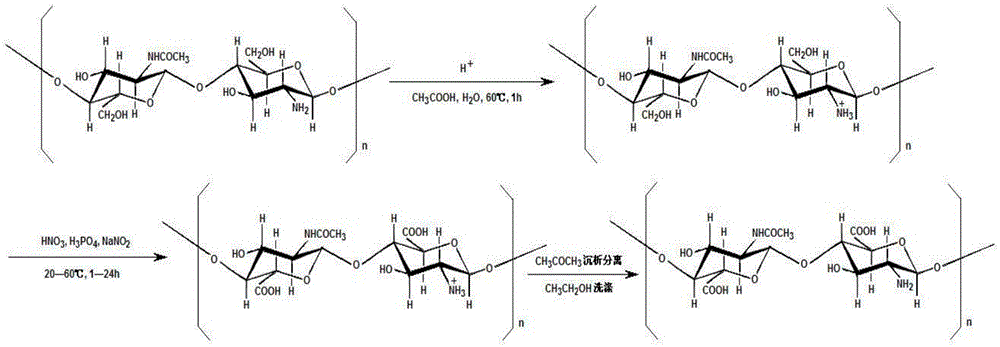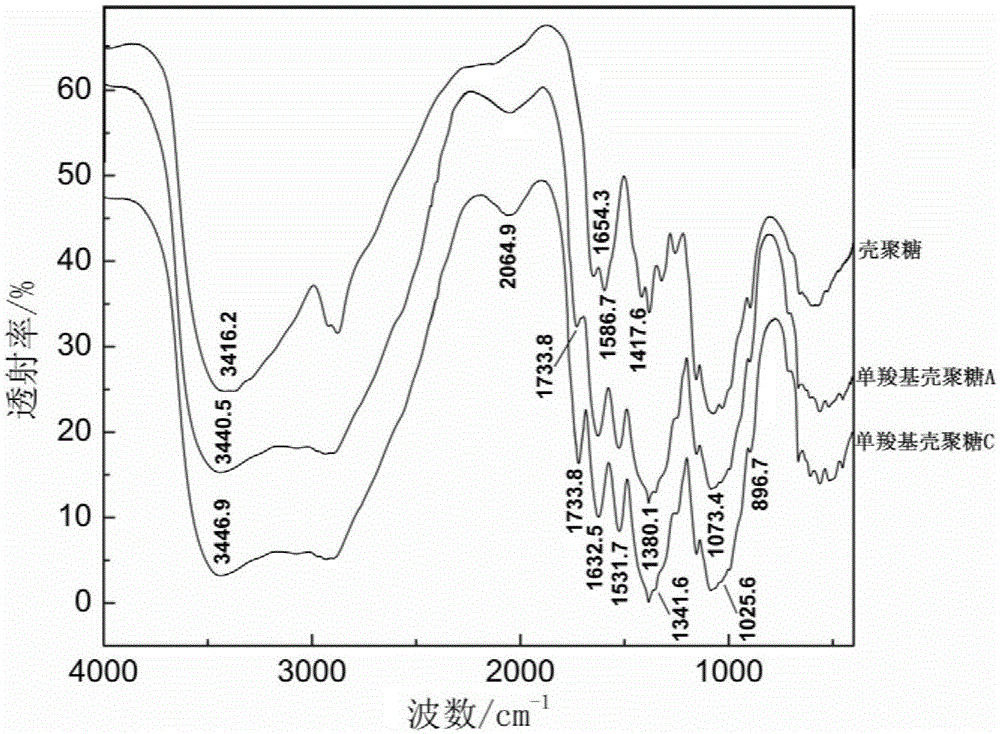Water-soluble antibacterial monocarboxylic chitosan as well as preparation method and application thereof
A single carboxyl, chitosan technology, used in textiles and papermaking, fiber processing, animal fibers, etc., to achieve high biocompatibility, mild reaction conditions, and less oxidant consumption
- Summary
- Abstract
- Description
- Claims
- Application Information
AI Technical Summary
Problems solved by technology
Method used
Image
Examples
Embodiment 1
[0037] Embodiment 1: monocarboxy chitosan preparation
[0038] Weigh 4.0g of chitosan with a viscosity-average molecular weight of 800,000 and a deacetylation degree of 85% and place it in a 2% (v / v) dilute acetic acid solution at a bath ratio of 1:25 (w / v), stir at 60°C Dissolve in 1 hour, cool to 40°C and add 15mL of mixed acid (V 浓 硝酸 :V 浓磷酸 =1:1), then add sodium nitrite with a mass volume ratio of 0.007g / mL to the mixed acid in a light-proof airtight container, and slightly shake it at 40°C for 2 hours, and immediately add 230mL of absolute ethanol after the reaction Terminate the oxidation reaction, the oxidation product is precipitated with acetone, vacuum filtered until the pH of the filtrate is about 6, washed with absolute ethanol, vacuum dried and refined to obtain a light yellow monocarboxyl group with a molecular weight of 180,000 and a carboxyl degree of 29.72%. Chitosan A, stored at 4°C for later use. After testing, the degree of deacetylation of the monocar...
Embodiment 2
[0040] Weigh 4.0g of chitosan with a viscosity-average molecular weight of 800,000 and a deacetylation degree of 85% and place it in a 4% (v / v) dilute acetic acid solution at a bath ratio of 1:25 (w / v), stir at 60°C Dissolve in 1 hour, cool to 25°C and add 15mL of mixed acid (V 浓 硝酸 :V 浓磷酸 =2:1), then add sodium nitrite with a mass volume ratio of 0.014g / mL to the mixed acid in a light-proof airtight container, and slightly shake it at 25°C for 3 hours, and immediately add 230mL of absolute ethanol after the reaction The oxidation reaction was terminated, the oxidation product was precipitated with acetone, filtered under reduced pressure until the pH of the filtrate was about 6, washed with absolute ethanol, dried in vacuum and refined to obtain a yellow single carboxyl shell with a molecular weight of 110,000 and a carboxyl degree of 40.36%. Glycan B, stored at 4°C for later use. After testing, the degree of deacetylation of the monocarboxychitosan B obtained in this exam...
Embodiment 3
[0042] Weigh 4.0g of chitosan with a viscosity-average molecular weight of 800,000 and a deacetylation degree of 85% and place it in a 4% (v / v) dilute acetic acid solution at a bath ratio of 1:25 (w / v), stir at 60°C Dissolve in 1h, cool to 25°C and add 21mL of mixed acid (V 浓 硝酸 :V 浓磷酸 =2:1), then add sodium nitrite with a mass volume ratio of 0.014g / mL to the mixed acid in a light-proof airtight container, and slightly shake it at 25°C for 8 hours, and immediately add 242mL of absolute ethanol after the reaction Terminate the oxidation reaction, the oxidation product is precipitated with acetone, vacuum filtered until the filtrate pH is about 6, washed with absolute ethanol, vacuum dried and refined to obtain a dark yellow single carboxyl shell with a molecular weight of 60,000 and a carboxyl degree of 53.57%. Glycan C, stored at 4°C for future use. After testing, the degree of deacetylation of the monocarboxychitosan C obtained in this example is 85.3%, the solubility in ...
PUM
| Property | Measurement | Unit |
|---|---|---|
| thermal decomposition temperature | aaaaa | aaaaa |
| thermal decomposition temperature | aaaaa | aaaaa |
| thermal decomposition temperature | aaaaa | aaaaa |
Abstract
Description
Claims
Application Information
 Login to View More
Login to View More - R&D
- Intellectual Property
- Life Sciences
- Materials
- Tech Scout
- Unparalleled Data Quality
- Higher Quality Content
- 60% Fewer Hallucinations
Browse by: Latest US Patents, China's latest patents, Technical Efficacy Thesaurus, Application Domain, Technology Topic, Popular Technical Reports.
© 2025 PatSnap. All rights reserved.Legal|Privacy policy|Modern Slavery Act Transparency Statement|Sitemap|About US| Contact US: help@patsnap.com



